Tuesday 31 January 2017
Monday 30 January 2017
Organic Check-Off Program: Protect Our Healthy Food Future


Today’s post is going to differ slightly from my health and wellness articles, but it’s a topic could affect all of us who are worried about the food supply and availability of organic foods for our family.
There’s a big new initiative on the horizon, and it affects a topic near and dear to my heart (and to many of yours as well, I’d wager):
How to get good food and more of it, for less!
It’s called the GRO Organic Check-off Program, and it’s the next big thing in the organic food industry. In fact, this idea has been years in the making. This program means that organic food producers will work together to make organic food more widely available than ever before … It would mean lower prices for organic food while still ensuring that our organic farmers are being given the best tools to stay profitable and successful and keep growing organic, while also driving down prices for consumers!
Sounds great, right? But organic farmers and the OTA (Organic Trade Association) need your support to make this plan a reality.
What’s a Check-off Program, Anyway?
Check-off programs in general are not exactly new. Does the phrase “Beef. It’s What’s for Dinner” sound familiar? Or maybe you’ve heard of the “The Incredible Edible Egg”? Check-off programs brought us these now famous advertising campaigns and very popular slogans.
The term “check-off” just means that producers of a certain type of food group (for example, all the beef producers) would check off a box indicating they wanted to participate in the program. They would then pay a fee toward the check-off fund. (Some check-off programs are in fact mandatory, which is controversial.)
These programs don’t promote one brand over another but the food commodity as a whole (eggs, beef, dairy, and now organics!).
An elected board puts the funds to work in a variety of ways. The check-off program handles education, marketing, advertising, strategic expansion into new markets, and so on. It’s worked wonders for many sectors of the food industry.
And it’s about to do the same for organic food, but only with our help!
Organic Check-off Program: Why The Time Is Now
American consumers clearly want organic food in their grocery stores. The Organic Trade Association (OTA) reports that this sector of the food industry has grown by double digits almost every year since the 1990’s. Recent years are no exception, with a 10. 8% growth rate and a record $4.2 billion in sales in 2015. (Compare this to the overall food industry which grew at a rate of about 3% that year.)
While the demand is great, the supply is not. The same report tells us that as of 2014 only 1% of America’s farmland produced organic food. If you’ve dabbled in economics, you know that high demand and low supply drives up prices … as we all know too well when we’re trying to decide between conventional or organic at the grocery store.
Up until now, the organic food industry hasn’t had an official national check-off program. The OTA describes exactly why the industry should band together now at this critical point:
“We can either leave consumers guessing about what organic is, or we can come together to educate the public about what the organic seal really means. We can be solely dependent on others for research dollars to help solve industry challenges, or we can generate a pool of funds to help ourselves. We can struggle to meet the growing demand for organic, or we can work together to grow domestic acres and encourage more farmers to transition.”
In short, there’s no time like the present to make organically grown food more available and cost effective than ever and to make sure the farmers that grow our organic foods have all the resources available to stay in business and to expand!
What An Organic Check-Off Program Would Do for You
The GRO Organic Check-Off Program has 3 main goals:
- Encourage more farmers to enter the organic food sector
- Help all organic farmers be more successful and profitable
- Increase consumer confidence by educating about what the organic seal really means
It’s estimated that the program would raise $30 million dollars per year to use toward these goals. More specifically, a nationwide organic check-off program would raise money for the organic industry to:
- Educate consumers about what the organic label really means
- Distinguish organic from lesser claims and unregulated seals like “natural”
- Confirm the science behind the environmental and public health benefits of organic
- Undertake research to solve problems such as invasive pests and weed control
- Bring new farmers into organic production through information and technical assistance
- Reduce the supply crunch by transitioning farmland to organic production across the U.S.
Small organic growers would no longer have to struggle alone but would have the support of a coordinated, nationwide organization with their best interests in mind.
And all of this means we get to feel better about our choices in the grocery store.
How to Get Involved Today
For the next two months, the USDA is asking for public comments in the Federal Register on the proposal for the GRO Organic Check-Off Program. Anyone—consumers, business owners, or organic food producers—can comment to show public support for this initiative that promises to make organic foods better understood, more accessible, and less costly.
Still have questions? Check out these helpful FAQs with all you could ever want to know about the GRO initiative!
Ready to vote for a better food future? The USDA wants to hear your opinion! Between January 18, 2017, and March 20, 2017, you can influence this decision by entering your comment of support at www.groorganic.net. Use your power as a consumer and let your voice be heard!

Do you think an organic check-off program is a good idea? If you do, be sure to register your comment and ask others to do the same!
Continue Reading...Organic Check-Off Program: Protect Our Healthy Food Future
source https://wellnessmama.com/147769/organic-food-checkoff/?utm_source=rss&utm_medium=rss&utm_campaign=organic-food-checkoff
64: How to Keep Your Family Safe With Tips from Former CIA Agent Jason Hanson


If you watch the news, it can feel as if life is never truly safe and that even a routine trip to the park with children can be a dangerous endeavor.
The truth is that we are statistically safer than we’ve ever been, but those statistics don’t matter to the families who have been victims of crimes. So how do you keep your family safe without living in constant fear and how do you separate common sense prevention from paranoia?
Learning from a Former CIA Officer
In this interview, I talk with Jason Hanson, a former CIA Officer and the New York Times bestselling author of Spy Secrets That Can Save Your Life. Jason has appeared on ABC’s Shark Tank, Fox & Friends, Dateline, NBC Today Show, and Rachael Ray, to name a few. He runs his Spy Escape & Evasion school on his 320-acre Spy Ranch in Cedar City, Utah.
Jason shares his story of how he became a CIA agent and how he uses the knowledge he gained through operative training to protect his family. He also teaches workshops to help men, women, and families take practical steps to keep safe.
In This Episode, You’ll Learn
- The number one way to reduce your chances of becoming the victim of a crime
- How criminals, when interviewed, could identify potential victims in seconds just from looking at pictures
- What to do if you are ever in a dangerous situation with your children
- The reason women (and especially moms) need to be concerned with self-defense
- Ways to teach your children to be safe at home and when out and about
- How to have a “family safety plan” for your home and what to do if an intruder ever enters
- What to do to reduce the chances of home invasion, car jacking, and kidnapping
- Simple tips to stay safe while traveling
- How to use some spare change and a sock for self defense
- The one place Jason would never take his family (hint: it is a popular vacation destination)
- A simple tool you can carry anywhere (even in airports) to help defend yourself
- If and when you should carry a gun or knife for protection
Resources We Mention
Special Thanks to Today’s Sponsors
This podcast is brought to you by Kettle and Fire Bone Broth. If you love the benefits of bone broth simmered on the stove all day but want a quick and easy way to make it, Kettle and Fire is for you! They have the first grass-fed (and grass-finished) non-perishable bone broth and it is ah-mazing! Kettle and Fire Bone Broth can be found in many Whole Foods on the west coast and you can also order online here.
I use their bone broth on a regular basis and used it to create the recipes in my new bone broth e-book (releasing later this year).
This podcast is also brought to you by Thrive Market. If you live in a real food desert like I do, it can be difficult to find certain organic, specialty, or allergy-friendly foods. Thrive Market makes it easy by carrying thousands of the non-perishable foods that I use most often at discount prices.
They’re like a combination of Costco, Amazon, and Whole Foods. They are online like Amazon, have a yearly membership fee to unlock discounts like Costco, and carry high quality foods like Whole Foods!
I order from them regularly and highly recommend them. Check out all of their products and grab a free jar of coconut oil here.
Continue Reading...64: How to Keep Your Family Safe With Tips from Former CIA Agent Jason Hanson
source https://wellnessmama.com/podcast/family-safety/?utm_source=rss&utm_medium=rss&utm_campaign=family-safety
Thursday 26 January 2017
Tabata Workout: The Powerful 4-Minute System That Works


Going to the gym can be impractical when you’re a mom of littles, but thankfully there are many great workouts that can be done from home. That’s why I’m such a fan of the Tabata workout, and it just might be the perfect choice for moms on the run … pun intended!
Tabata Workout: Not for the Faint of Heart
A Tabata workout is a high-intensity workout. Although it lasts only a few minutes, it will really kick your tail. They’re perfect for those of us who don’t have a lot of time to devote to fitness but want to get in a good workout.
Note: Those with any condition that prevents strenuous exercise should not do a Tabata workout without an OK from a doctor!
Tabata Workout: Perfect for Moms
I get it … you’re busy! It takes time to prepare healthy food from scratch every day (What? They want dinner again? I just cooked last night!). It also takes time to make healthy cleaning products, or follow a natural beauty routine, or research how to best take care of your family. Living a life of wellness is a full-time job.
But staying fit is important, too.
That’s why the Tabata workout is so perfect for busy moms! It only takes four minutes. Literally, four minutes and you get an intense workout.
But What Is a Tabata Workout?
I’m so glad you asked. Here’s the gist: sprint hard for 20 seconds; rest for 10 seconds; repeat for a total of four minutes (generally 6-8 rounds). That’s it. Sounds simple, but this short workout can burn some mean calories.
Developed by Dr. Izumi Tabata in Japan, Tabata exercise has been found to be superior to other types of exercises. In a 1996 study done at the National Institute of Health and Nutrition in Tokyo, Dr. Tabata and his colleagues studied two groups of athletes: one group did medium-intensity exercise for long periods of time and the other did high-intensity exercise for short periods of time.
Tabata and his team observed the athletes for six weeks, and after that time, it was found that the first group increased their aerobic capacity (how long you can run) by 9.5% and their anaerobic capacity (how long you can run at maximum effort) by 0%, while the second group increased their aerobic capacity by 14% and their anaerobic capacity by 28%.
The second group showed greater improvement in lung capacity and oxygen utilization, while the first group showed only minimal improvement, thus proving the benefits of short, high-intensity training.
How to Train for Tabata (Hint: Slowly)
The Tabata regimen was originally created for elite athletes as a means of improving athletic performance. If you’re like the average mama, you may need to work your way up—train so to speak—for Tabata sprints.
You can start by doing some simple interval training:
- Begin with longer, less intense sprints, with a longer recovery time in between.
- Instead of 20 seconds of all-out running, try 60-90 seconds of mid-intensity running, followed by a one minute break rather than ten seconds.
- Every few days, increase your intensity and shorten your exercise and break times.
- Start with only a couple of minutes and work your way up to four minutes, a few times a week.
The Unique Advantages of a Tabata Workout
Burns fat – Intense cardio burns calories and melts away fat. But more than that, it may affect how our bodies process glucose, a huge contributor to belly fat. One study found that “a high amount of moderate-intensity exercise alone was very effective at improving oral glucose tolerance….” Intense exercise may help how our bodies process sugars.
Builds muscle – Tabata exercise allows gives muscles an intense workout.
Creates endorphins – Exercise gives you endorphins. Endorphins make you happy. Happy people just don’t shoot their husbands. They just don’t.
Highly portable – No fancy equipment or special place needed for this workout!
Short and sweet – Get your exercise out of the way quickly … a bonus for every busy mama.
Other Tabata Variations: Not Just for Runners
Armed with Dr. Tabata’s research, you can apply the Tabata exercise principle to any type of workout. In fact, cycling is one of the more popular ways to utilize the method.
Other great workouts to use the Tabata principle with:
- jumping rope
- squats
- push ups
- pull ups
- kettlebell training
- basically any type of exercise—get creative and have fun with it!
How to Do Tabata, Step by Step
Are you ready to give Tabata sprints a try? Remember, make sure to work your way up, starting with gentler interval training. Once you’ve done that, get ready—this intense workout will kick your exercise regimen into high gear!
Step 1: Start by stretching. You want your muscles nice and warm, because the level at which you’ll push them can lend itself to pulled muscles. Even better if you can do your workout in a warmer place versus outdoors on a cold day.
Step 2: Get a timer ready. Make sure you can easily see a clock with a second hand or have a timer handy.
Step 3: Run, Forrest, run! Run as hard as you can for 20 seconds.
Step 4: Rest. Take a breather for 10 seconds.
Step 5: Repeat. Again, run for 20 seconds, followed by a 10 second breather. Repeat 6-8 times, for 4 minutes total. (Many people, even well-trained athletes, can’t make it past 6 times. That’s normal, and, it should be noted that if you’re not struggling, you’re probably not working hard enough. Tabata sprints are meant to be difficult.)
Step 6: Cool down. Stretch again, catch your breath, and sip some room temperature water. Allow your body to come back to normalcy gently.
That’s it. The whole process should take less than 30 minutes.
How Often Should I Do Tabata Sprints?
Because Tabata sprints are such an intense workout, only two to three times a week should be plenty. You can do weight lifting and gentle exercise like yoga the other days of the week. It should also be noted that the long-term benefits and enjoyment of Tabata sprints may wane, which is why pro athletes typically do them during training seasons and not year round.
Health experts remind us:
For the majority of the population, improving longevity and general health can be done by brisk walking for 20 minutes three times a week – and doesn’t involve spending money joining a gym. (source)
It’s reassuring to know that the best health benefits come from consistent, no-fuss, moderate exercise and a varied routine.
Make Your Wellness Matter
Above all, when we’re taking care of a family, our own wellness should be a priority. It’s easy to let my own needs go by the wayside when I’m taking care of everyone else, but there are a few things I know I should prioritize. If I’m healthy, I can keep everyone else healthy.
By taking advantage of the fast and easy exercise Tabata sprints provide, you can check more one thing off your “keep mama healthy” list.
Continue Reading...Tabata Workout: The Powerful 4-Minute System That Works
source https://wellnessmama.com/130119/tabata-workout/?utm_source=rss&utm_medium=rss&utm_campaign=tabata-workout
Tuesday 24 January 2017
Benefits of Onions: A Powerful Home Remedy

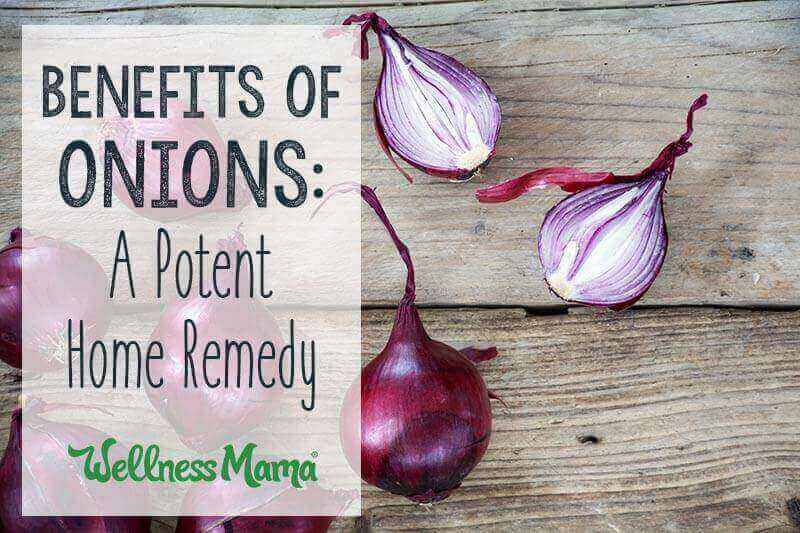
If vegetables could be superheroes, onions would definitely be at the top of the list. This unassuming root vegetable boasts an impressive host of health benefits. Onions are also endlessly versatile, and the fact that most of us already have a few on hand at all times makes them an ideal home remedy you can whip up when a cold or flu is coming on.
The Powerful Health Benefits of Onions
Onions and garlic are both in the allium family and share many of the same health benefits. The word allium literally means “I smell,” and we all know onions are certainly known for their pungent scent.
Onions are potent in other ways too. They contain high levels of vitamin C, folate, potassium, phosphorous, magnesium, potassium, and calcium. They are also high in the antioxidant quercetin.
Quercetin has been shown to protect against many different types of cancer in the body, boosts immune response, and is even used to help with cataracts. The quercetin in onions has also been studied for its ability to improve heart health, prevent heart disease, and keep blood flowing freely throughout the body when used daily.
Yellow onions generally have more quercetin than red or white onions (and are usually the most affordable anyway!).
Other Interesting Facts about Onions
- Onions are high in sulfuric compounds that have been shown to kill even salmonella and E. coli. These compounds also help prevent cancer and heart disease.
- In the past it was recommended to place bowls of onions around the room so they would absorb any germs around.
- Onions build both bone and mineral density to help prevent osteoporosis.
- Onions are so healthy, that even in this study when they were fried, they increased blood quercetin from 28.4 ng/ml to 248.4 ng/ml. It also increased participants’ overall antioxidant ability.
- Chewing on raw onion will relieve a toothache, kill germs, and help prevent tooth and gum disorders. Just be sure to brush your teeth really well afterward!
- Onions are full of fructooligosaccharides that encourage beneficial bacteria, yet target harmful bacteria in the gut.
- Onions lower blood sugar levels and improve insulin levels.
7 Onion Home Remedies You Can Count On
1. Onion Poultice to Relieve Congestion and Coughing
Onions work like an expectorant. They help break up mucus and congestion in the chest and reduce spasmodic coughs.
Onions work best for a chest poultice if they’re heated first. To break up chest congestion and soothe a spastic cough, you can apply a poultice externally, or take an onion syrup or tincture internally.
To make an onion poultice:
- Slice or dice an onion, add 1 tablespoon of water, and cook until the water evaporates.
- Allow the onion to cool to a comfortable temperature, then wrap the onion in a small towel, like a tea towel. Gather the ends of the towel together and secure with a rubber band.
- Place the poultice on the chest or back and leave it for 30 minutes, repeating the process every 3 hours or until the symptoms are gone.
An onion poultice is smelly for sure. To help with this I sometimes apply the poultice to the feet, wrap them in cloth or plastic, and cover with socks.
2. “Fire Cider” Immunity Booster
Fire cider is an age-old remedy made from onions, horseradish, garlic, cayenne pepper, and other aromatic plants steeped in apple cider vinegar. Onions are used in this recipe because of their potent antiviral and antibacterial compounds and their ability to support the immune system. You can get my easy recipe for fire cider (I call it “Spicy Cider”) here.
3. Onion Honey Syrup
An onion syrup is a delicious way to take your medicine. Some people use sugar to make a more traditional syrup but I prefer to use raw honey for even more health benefits. An onion honey or syrup can be taken for any cold or flu, especially if a cough or congestion is present. You can also take a spoonful every day during the winter months to help keep sickness away.
Don’t go overboard with drinking this, though, as too much can cause digestive issues.
To make an onion honey syrup:
- Thinly slice an onion and add it to a saucepan. Pour honey over the onion, just until covered. You should only need about ½ cup, maybe less.
- Gently heat the honey over very low heat, until the onions are soft and translucent. You don’t want the mixture to get over 115 degrees, or the honey will no longer be raw.
- Take a spoonful of the onion honey every 3-4 hours, or until symptoms subside. To use as a preventative measure, take a spoonful or two every day during flu season.
4. Onions for Ear Infections
You may have used garlic oil for an ear infection in your kids before, but onion can be used in much the same way. A roasted or baked onion half can be cooled to a comfortable warmth and placed on the ear. This helps to relieve painful inflammation and fight the bacterial or viral infection in the ear. You can also squeeze the juice from the onion and place a few drops in the ear.
Be sure that the onion mixture is very well strained, since you don’t want any onion pieces in the ear. And never put anything in the ear if you suspect that there’s a possibility of a ruptured ear drum!
It’s always best to treat both ears even if your child only complains of pain in one, since the infection frequently spreads to both ears eventually.
5. Onion Soup
Soup is one of the easiest and tastiest ways to get more onion into your diet. Save your onion peels and add them to chicken bones and other veggies when you make bone broth. Researchers in this study thought that the onion as a whole, including the onion skin, contains higher levels of quercetin than just the onion alone. This means that saving your onion skins for a nutritious broth not only adds flavor, but potentially boosts the nutritional value more than the part you would eat.
My soothing garlic soup recipe includes onion and packs a powerful anti-sickness punch. You can also make some French onion soup to drink. The healing goodness of onion soup not only helps the body fight colds and flu but also bladder, kidney, and chronic urinary tract infections.
6. Onions for Sore Muscles, Sprains, and Strains
Onions are rubefacient, meaning they draw blood to the surface of the skin and increase circulation. The ancient Greeks rubbed onions on sore muscles to stimulate and warm them. Onions also reduce inflammation, making them perfect for bruises, strains, sprains, and even rheumatism. Just apply an onion poultice (above) to the affected area.
7. Onions to Draw Out Infection
Onions have been used for centuries to remove infection from damaged skin. Their properties will draw out pus from boils, bee stings, and the poison from an insect bite or bee sting. You can apply a fresh onion slice or onion poultice to the affected area.
Favorite Onion Recipes
Try these other onion recipes to get this health food into your diet. Since heat destroys some of the onion’s antimicrobial properties, it’s helpful to eat them raw sometimes, like in the cucumber salad and pickled red onion recipes below.
Have you ever used onion as a remedy before? What are some of your favorite ways to use/eat this veggie?
Continue Reading...Benefits of Onions: A Powerful Home Remedy
source https://wellnessmama.com/140334/benefits-of-onions/?utm_source=rss&utm_medium=rss&utm_campaign=benefits-of-onions
Monday 23 January 2017
The Benefits of Seaweed (And When To Avoid It)
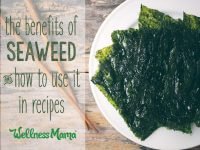
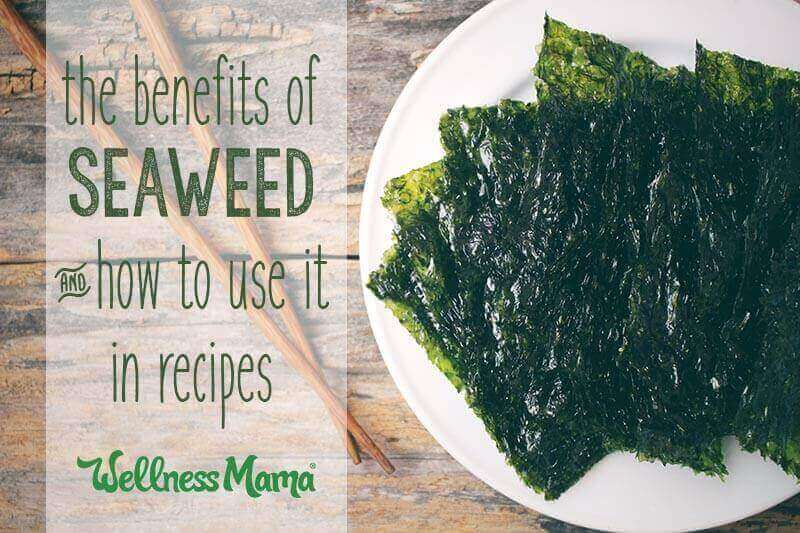
Most of us are familiar with seaweed in our sushi, and the accompanying miso soup. But beyond the delicious taste, have you ever wondered about the health benefits of seaweed?
Incredibly rich in antioxidants, vitamins, and minerals, seaweed packs a serious nutritional punch.
What Is Seaweed?
Seaweed, or algae, belongs to a group of plant-like organisms that grow in the sea.
Some algae are one-celled organisms such as microalgae, which means that they are more like bacteria that also generate energy through photosynthesis.
Most of the seaweed that we consume as food have many cells. Seaweed is part of a healthy diet and is used in herbal medicines in many traditional cultures.
What Are the Different Types of Seaweed?
Scientists have categorized types of seaweed into different categories based on their pigments, cell structure, and other traits. The groups (or phyta) of seaweed that are commonly consumed include:
- Green algae such as sea lettuce or ulva, and sea grapes
- Brown algae such as kombu, arame, kelp, and wakame (the miso soup seaweed)
- Red algae such as dulse, laver, and nori (the sushi seaweed)
- Blue-green algae such as spirulina and chlorella
How to Cook and Eat Seaweed
If you live near an Asian market or Chinatown, you may be able to find fresh seaweed. Otherwise, you may find many types of dried seaweeds in the supermarket and online, such as on Amazon.
Dried seaweed would need to be soaked in hot water, and rinsed well before use. Some thicker and tougher seaweed like kombu might be better sliced thin or boiled.
Seaweeds are very versatile. Here are a few different ways to enjoy them:
- Snacking out of a bag – Nori and dulse can just be eaten out of a bag. You do want to check the labels and watch out for some brands of snacking nori that contain a lot of MSG. Seasnax is a good brand for this that uses seaweed from Korea and clean ingredients.
- Salads – Most types of seaweed can be made into a Japanese-style salad with vinegar, sesame oil, ginger, and garlic. Try this recipe.
- Soups – Seaweed tastes delicious in bone broth, which makes it seaweed soup.
- Sprinkled on other foods – Seaweed flakes can be sprinkled on salads, rice, soups, or any other dishes.
Most seaweed is not bitter. Some types are a bit sweet and may even have umami flavors, which means that it may be easier to get some picky eaters to eat seaweed than vegetables.
Benefits of Seaweed
The unique properties of seaweed make it beneficial to the body in several ways:
Vitamins and Minerals
Seaweed is much more nutrient dense than any land vegetables. It is an excellent source of micronutrients including folate, calcium, magnesium, zinc, iron, and selenium. More importantly, seaweed is a great source of iodine.
DHA and EPA omega-3 fatty acids
Unlike land plants, seaweed contains preformed omega-3 fatty acids DHA and EPA, so seaweed or algae oil can be a reliable source of omega-3 for vegetarians.
Aids with Digestion
Beans can cause gas and stomach upset for many people. This can be easily fixed by adding kombu, a particular kind of seaweed, to the beans when cooking.
Antioxidants
Seaweed contains many antioxidants. As part of a healthy diet, seaweed can help protect against oxidative stresses and prevent chronic diseases such as cancer and digestive problems.
Fiber and Prebiotics
All plants contain fiber, but seaweed also has other odd types of carbohydrates that we lack the digestive enzymes to digest. These include carrageenan, fucan, galactan, and many more. These carbohydrates then become foods for the bacteria (see this study for a more detailed explanation).
What you eat directly influences which bacteria dominates in your gut. The types of bacteria that can feed best on the foods you choose to eat will grow better (read more on this fascinating topic here). This explains why some cultures handle different types of food better than others. In fact, scientists found that the gut bacteria in healthy Japanese people are higher in bacteria that can digest the types of carbohydrates in seaweed (source).
Potential Risks from Eating Seaweed
There are a couple potential concerns to be aware of when consuming seaweed:
Too Much Iodine Can Cause Thyroid Problems
Iodine is a very important mineral for thyroid functions, and seaweed is a great source of iodine. While the thyroid can adjust to higher intakes of iodine, it is possible to develop thyroid problems from too much iodine. This may be especially true if you are susceptible to thyroid problems.
A Japanese study found that women who regularly consumed 15 – 30 grams of kombu had elevated TSH, and reduced free T3 and T4. When these women stopped consuming seaweed, then their TSH and thyroid hormone levels returned to normal. Therefore, the authors of this study recommended not to exceed 3 mg of iodine (a serving of seaweed typically contains 20 – 50 mg).
Asian cuisines typically serve seaweed along with foods that contain goitrogens that inhibit iodine absorption by the thyroid. These include the common Asian staples such as tofu, soy milk, and cruciferous vegetables. This might explain why most Japanese and other Asian people can consume seaweed without any problem (source).
Those with existing thyroid disease (or those predisposed to it) should monitor total iodine intake. This is especially important for those who live in countries that fortify foods and table salts with iodine. Generally, consumption of seaweed on occasion (2 – 3 times a week) as a condiment (1 – 2 tablespoons) generally will not exceed the 3 mg limit of iodine.
To be safe, monitor thyroid hormone levels with your doctor as you introduce seaweed into your diet to see if eating seaweed will possibly cause a thyroid problem for you.
Digestive Problems from Seaweed Carbohydrates and Fibers
Seaweed contains many types of carbohydrates our digestive system can’t digest. These carbohydrates are passed down to our gut bacteria. For people prone to digestive problems or with small intestinal bacterial overgrowth, these carbohydrates cause significant issues.
The food industry widely uses these carbohydrates, such as carrageenan and agar, to stabilize or texturize foods in the food industry. Carrageenan, in particular, is very problematic. It causes inflammation both in the gut and throughout the human body. It is therefore very wise to avoid carrageenan as a food additive (read more about this here).
While pure carrageenan has been linked to health problems, there is no study linking carrageenan in whole food sources to the same problems that have been linked to carrageenan in isolation. It is perhaps best to avoid seaweeds that are higher in carrageenan content such as Irish moss and occasionally enjoy other seaweeds in moderation.
Radioactive Levels from Fukushima Radiation
A high iodine diet can protect against radioactivity. This is why when the Fukushima nuclear plant melted down, the Japanese government gave iodine supplements to aid workers and evacuees.
Chris Kresser discusses the topic of Fukushima radiation in Pacific seafood in this blog post. He states that the levels of radiation in the US Pacific coast are rather insignificant when compared to other background sources of radiation that already exist in the US, or compared to our exposure flying on an airplane. Bottom-feeding fish near the coasts of Japan show more contamination, but even then the levels of radioactivity fall below the international dose limit.
In fact, Maine Coast, a seaweed purveyor that regularly tests their products for toxins, found that their products only have background levels of radioactivity even right after the Fukushima event in March 2011 (source).
Because seaweed is at the bottom of the food chain (where it is eaten by other animals), the concentration of toxins in seaweed is much less than in fish or other animals that eat the seaweed.
Toxic Heavy Metals
While rich in beneficial minerals, seaweed also can contain toxic metals. This likely depends on the type of the seaweed, where it is harvested from, and the variation of toxin levels in the water. Several reports detail the heavy metal content of seaweed:
- Heavy metals in laver, seatangle, sea mustard, hijiki, and gulfweed from the South Korea coast are below safety limits (source, source2).
- Hijiki, regardless of brand, contains arsenic that is above the safety limit (source).
- A Spanish study extensively compared various types of seaweed imported from Japan, China, Korea, and Chile that are sold in Spain. They concluded that most seaweed products are safe with respect to WHO guidelines. However, some species such as Hijiki and H. fusiforme may be high in arsenic (source).
Heavy metals levels in seaweed can really vary from batch to batch. The best way to know for sure is to purchase your seaweed from companies that regularly third-party lab test their products for heavy metal levels. One company I like that does this is Maine Coast. They publish their test results on their website here.
Remember that heavy metal exposure also comes through other sources like the environment and foods like fish and seafood. Everyone’s ability to remove these heavy metals from their bodies differs. If you are concerned about heavy metal levels, it might be wise to avoid seaweed and seafood altogether.
Seaweed as a Superfood: How It Stacks Up
- There are many benefits of seaweed and it is a very nutritious food.
- Healthy people can enjoy seaweed as a condiment a few times a week.
- If you have concerns about thyroid health or digestive function, you may want to speak to your doctor about monitoring your condition as you introduce more seaweed into your diet.
- With a few exceptions, radioactivity and heavy metal toxicity of low concern for seaweed.
- In general, seaweed harvested from the Korean coast is quite safe.
When in doubt, purchase your seaweed from a reputable company that tests their products for contamination, such as Maine Coast.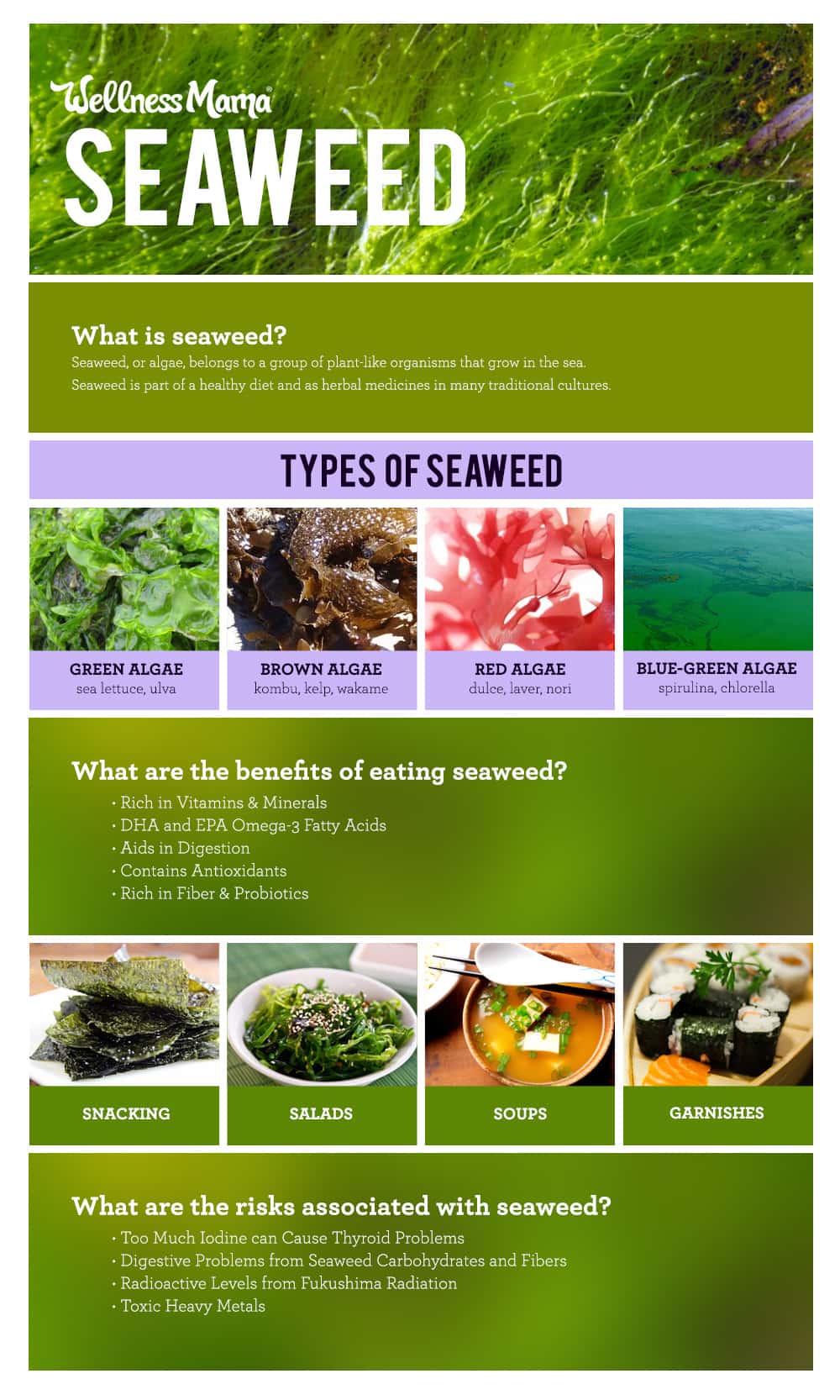 What is your experience with seaweed? Do you have any concerns about its safety?Please share in the comments below.
What is your experience with seaweed? Do you have any concerns about its safety?Please share in the comments below.
Continue Reading...The Benefits of Seaweed (And When To Avoid It)
source https://wellnessmama.com/130117/seaweed-benefits/?utm_source=rss&utm_medium=rss&utm_campaign=seaweed-benefits
63: How to Choose a (Truly) Healthy Wine with Todd White

As a mom of six, it’s long been part of my weekly ritual to sit down with my husband after the kids are in bed and enjoy all a good glass of wine has to offer. But as my diet improves (and as I get older … ahem), I find I’m more and more likely to get hangover-like symptoms, even from just one or two glasses of wine.
This is a problem! And one that isn’t as simple as sulfites, as many commonly think.
Thankfully, I discovered Todd White, wine expert from the Napa Valley, and the amazing Dry Farm Wines company. Dry Farm Wines works with small family vineyards all over the world to provide pure, natural wines that are also … get this … sugar free!
Dry Farm Wines: The Best Wine for Your Health
It all started when Todd set out to solve a personal problem: how to still indulge his passion for wine while avoiding the #1 public health enemy, sugar. His solution grew into Dry Farm Wines, the only lab tested, all natural, health quantified wine merchant in the world today.
Dry Farm “biohacks” wine so we can have all of its health benefits without the downsides. Many leading U.S. health influencers endorse these wines, including Mark Sisson, Dave Asprey, Robb Wolf, Abel James, the Fat Burning Man, and others (and now me!).
Todd’s expertise on wine is vast, and I can’t thank him enough for sharing what he knows so I can keep enjoying a good glass of wine!
In This Episode, You’ll Learn
- The many health benefits of wine (especially red wine) within moderation
- How to choose the best wines that won’t give you a headache or add to your waistline
- The inside scoop on the commercial wine industry’s practices and labeling
- Why not all natural wines are sugar free
- The shocking hidden additives in wine like heavy metals, artificial coloring, and animal byproducts (and how to avoid them)
- How the Ketogenic diet works and why so many people choose it as a lifestyle
- Why meditation is the greatest biohack in all of history
- The benefits of deep breathing practices, cold therapy, and other alternative approaches to health
- And more!
The Dry Wine Farming Difference
So how does Dry Farm Wines accomplish what they do? Can sugar-free, low-carb wine really taste good?
The truth is, traditional wine making practices produce the best (and lowest sugar) wine. Just like with food, the industrialization of winemaking over the last fifty years has lowered the quality of wine by choosing cheap, fast methods of production.
For this reason, Todd recommends wine not from the U.S. or the Napa Valley, as you might think, but wine from small vineyards in Europe.
One big difference? Dry farming.
The U.S. leads the world in the irrigation of grapevines with almost 100% of all vineyards in the U.S. being drip irrigated. This might seem like a harmless enough practice, but most of Europe has outlawed irrigation, and for good reason.
Todd explains why irrigation isn’t as harmless of a practice as it might seem:
When the fruit ripens on a grapevine, the physiology of that ripening process is deeply impacted by irrigation…. This is the reason that the Europeans don’t irrigate. It’s because the character of the taste of the fruit fundamentally changes.
And it’s not just taste that’s sacrificed. Higher water content means the grape will need to have a higher sugar content to make good tasting wine. The higher the sugar content at the time of picking, the higher the level of alcohol (and sugar byproducts like glycol) in the final product.
All this has a health impact. Dry farming practices make the grapevine grow deeper roots, produce more complex tasting fruit, and lower the water, sugar, and final alcohol content.
Which means no more headaches for us!
Other Benefits of Dry Farm Wines
- Comes from small European vineyards that use the purest natural farming methods on the planet
- Dry farmed without irrigation
- Low 7-12.5% alcohol content (commercial wines can be up to 24% alcohol)
- Lab-tested to be sugar and carb free (even natural wines can have 0 to 300 grams per liter)
- Lab-screened for absence of mold and toxins
- No added sugar or chemical additives
- Never uses sawdust or wood chips for fake oak flavor
- No or minimal sulfites
- Delivery to your door
In fact, you can now try my favorite wine for only a penny! Check out this exclusive Wellness Mama offer.
Do you enjoy wine? Have you ever experienced negative side effects from drinking it even in moderation? Please share what has and hasn’t worked for you!
Resources We Mention:
Dry Farm Wines Website
Dry Farm Wines Facebook
Dry Farm Wines Instagram
Dry Farm Wines Twitter
Special Thanks to Today’s Sponsors
This podcast is brought to you by Kettle and Fire Bone Broth. If you love the benefits of bone broth simmered on the stove all day but want a quick and easy way to make it, Kettle and Fire is for you! They have the first grass-fed (and grass-finished) non-perishable bone broth and it is ah-mazing! Kettle and Fire Bone Broth can be found in many Whole Foods on the west coast and you can also order online here.
I use their bone broth on a regular basis and used it to create the recipes in my new bone broth e-book (releasing later this year).
This podcast is also brought to you by Thrive Market. If you live in a real food desert like I do, it can be difficult to find certain organic, specialty, or allergy-friendly foods. Thrive Market makes it easy by carrying thousands of the non-perishable foods that I use most often at discount prices.
They’re like a combination of Costco, Amazon, and Whole Foods. They are online like Amazon, have a yearly membership fee to unlock discounts like Costco, and carry high quality foods like Whole Foods!
I order from them regularly and highly recommend them. Check out all of their products and grab a free jar of coconut oil here.
Continue Reading...63: How to Choose a (Truly) Healthy Wine with Todd White
source https://wellnessmama.com/podcast/healthy-wine/?utm_source=rss&utm_medium=rss&utm_campaign=healthy-wine
Thursday 19 January 2017
Can a Weighted Blanket Transform Your Kids’ Sleep?


Let’s be honest … parents will do just about anything to get their kids to sleep. Sleep is what makes a parent’s world go ’round. We need good sleep, and we desperately need our kids to get good sleep, too. Recently, I’ve read about how a weighted blanket may be able to help kids sleep.
While there are lots of natural remedies that can help kids sleep, like tart cherry juice, breathing techniques, and inversions (read more about those tricks here), weighted blankets provide restful sleep on a different level.
What Is a Weighted Blanket?
Weighted blankets are specially made blankets that contain a weighted material, usually some kind of plastic bead, sewn into a grid design to be dispersed evenly throughout the blanket, between two layers.
Blankets can be made in differing weights to accommodate the size of the user. Even small children can enjoy lighter weighted blankets, while bigger kids will need heavier blankets.
Why Use One?
Weighted blankets have been shown to be beneficial for anyone having trouble sleeping, as well as those suffering from anxiety. They are an especially non-invasive way to help children who have trouble falling asleep.
Who Needs One?
Weighted blankets especially benefit those suffering from anxiety or insomnia. They are particularly helpful for children on the autism spectrum, who crave touch and pressure but are unable to tolerate typical physical touch from loved ones.
These children become sensory-seeking because, although they need stimulation, they cannot endure hugs and squeezes that neurotypical kids enjoy. Temple Grandin, a noted animal expert and advocate for those on the autism spectrum (and autistic herself) recalls the sensation of being touched as a child:
I would stiffen and pull away when people touched me, and I was oversensitive to both touch and sound…. (source).
Temple went on to complete a study of a device she built, called the “Squeeze Machine,” which exerted deep touch pressure to users. The study found that deep touch pressure benefited children with autism and ADHD by calming them. It also reduced self-injuring and stimulatory behaviors.
Studies have also found that babies, especially those born prematurely, benefit from deep touch pressure. As for the calming effects of a weighted blanket for sleep, Temple reports: “A high functioning autistic woman stated, ‘I need heavy blankets on me to sleep well, or else my muscles won’t calm down.'” (source).
Weighted blankets provide the calming touch those on the spectrum need, in a way they can receive it.
Can Weighted Blankets Benefit Neurotypical Children?
While it may seem that weighted blankets are clearly a help for children on the spectrum who need the calming effect of the weights, weighted blankets can benefit all children.
Parents have reported that, despite the blankets being originally designed to benefit children on the autism spectrum and with sensory processing disorder, their children without such a diagnosis have experienced extraordinary benefits from using a weighted blanket, primarily in the form of better sleep.
A writer for Forbes Magazine reports: “When word got out among parent friends at my son’s school that [weighted blankets were] turning moody 10-year-olds into well-rested angels, everyone started tucking in.” He goes on to say his 10-year-old son began sleeping more soundly and waking up happier and more focused after regularly using a weighted blanket, and that other parents reported similar results. (source).
How Weighted Blankets Work
The pressure from a weighted blanket actually affects the brain, causing it to release neurotransmitters like serotonin and dopamine, which improve mood and induce a calming effect.
For jittery kids who spend all day at school or too much time indoors during cold winter months, a weighted blanket may be just the trick to calm nervous energy before bed and help to prolong deep sleep. The deep touch pressure provided by weighted blankets calm the nervous system as well, which is necessary for good sleep.
How to Find a Good Weighted Blanket
Weighted blankets have become common enough that you can find them easily online.
What to look for:
- Choose a fabric your child will enjoy; many weighted blankets are made from a soft minky or fleece material.
- Pay attention to weight; blankets should typically weigh between 5-10% of your child’s body weight plus 1 or 2 additional pounds, though suggestions vary.
- Choose a blanket size that will work for your child; sizes can range from a small lap blanket to ones large enough to cover a bed.
This is a highly rated blanket on Amazon, which comes in a variety of weights and sizes.
How to Make a Weighted Blanket
If you’re familiar with simple sewing techniques, you may be able to try your hand at making your own weighted blanket. Most pre-made blankets contain plastic beads and I’m not a fan of plastic (to put it gently). Avoid the plastics and all their endocrine disruptors by making your own with an alternative substance like rice or beans. Of course, using rice and beans makes the blanket non-washable so consider this as well.
You’ll need:
- a sewing machine
- fabric: a nice, soft fabric like cotton fleece, in a pattern your child will enjoy is perfect. Patterns with lines like plaid make it easier to sew a straight line and make your grids even. Determine the size you’ll need and plan accordingly, getting enough for two layers.
- polypropylene beads for filling or rice (not washable if you use rice!)
- matching thread
- a kitchen scale
- a funnel
To make a weighted blanket:
- Prepare the fabric by making sure the layers are even.
- Stitch the bottom and two sides of the blanket together. Use binding or tuck in the edges to create a hem.
- With a fabric pencil, mark off the grid design on the fabric.
- Divide the poly beads by the number of boxes in your grid and determine how much will go in each box.
- Sew the vertical lines of the grid from the bottom hem to almost the top of the blanket, leaving a couple inches at the top.
- Pour enough beads in each row for one box.
- Sew the horizontal line over each scoop of beads in the blanket to create the first row.
- Repeat until you get to the top of the blanket, then finish the vertical lines at the top and hem the final edge to finish the blanket.
For a super detailed tutorial, complete with pictures, check out these instructions here.
Try a Weighted Blanket
Whether you choose to go the DIY-route or buy a ready-made blanket, there’s good reason to try a weighted blanket to help your kids sleep better. The calming, soothing pressure that a weighted blanket provides can help children with processing disorders, or kids who just need a little help to fall asleep or calm down after a long day.
Here’s to better sleep, which I think is every parent’s dream!
Do you think a weighted blanket would help your child sleep better? Share your experience in the comments!
Continue Reading...Can a Weighted Blanket Transform Your Kids’ Sleep?
source https://wellnessmama.com/130140/weighted-blanket/?utm_source=rss&utm_medium=rss&utm_campaign=weighted-blanket
Tuesday 17 January 2017
DIY Himalayan Salt Scrub Recipe + Tutorial
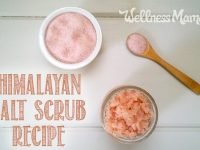

It’s always nice to get a little pampering in, especially as a busy mom. It’s even better when your pampering time nourishes your body, eliminates toxins, and even fights cellulite. With this grapefruit mint Himalayan salt scrub, you can accomplish just that.
Why a Scrub?
Just the act of rubbing the skin helps to stimulate fluid flow, reduce cellulite, and improve the overall tone and health of your skin. Dry brushing is a great way to accomplish this, but a Himalayan salt scrub will also stimulate your skin and provide even more benefits. By adding some essential oils, you’ll up the skin benefits even further and add a hearty dose of mood-improving aromatherapy.
Most scrubs include a carrier oil of some kind to help the scrub glide over the skin. This recipe uses coconut oil for its amazing skin benefits, and some lighter sweet almond oil to tone it down while still moisturizing. I’ve also included a small amount of castile soap to help cleanse the skin as you moisturize, for a truly all-in-one scrub.
Himalayan Salt Benefits
Himalayan salt is my favorite sea salt to keep around because it’s so rich in minerals and trace elements, like calcium, magnesium, and iron. When consumed it can help to eliminate toxins, balance electrolyte and pH levels, strengthen bones, and support circulation to name a few things. In this scrub you’re nourishing your skin with all of the minerals and trace elements of the salt (source).
Why Grapefruit Essential Oil?
Grapefruit essential oil helps to stimulate the lymphatic system and eliminate excess water weight. It also helps to boost circulation and diminish the appearance of cellulite. This study found that even smelling grapefruit can boost metabolism and speed weight loss. It’s also very high in limonene, which helps protect cells from free radical damage (source).
Soothing Peppermint
Although more commonly used for digestion and to aid in clear breathing, peppermint oil with its menthol content also makes an invigorating salt scrub. Peppermint helps wake you up and increases energy. It can also help to balance oil production for clearer skin. I like using it to help soothe headaches. Being a very strong oil, make sure that you only use it properly diluted, and not on little children.
Himalayan Salt Scrub Ingredients
- 1 cup finely ground Himalayan salt
- 1 T coconut oil
- 2 T sweet almond oil
- 1 T castile soap
- 20 drops grapefruit essential oil
- 2 drops peppermint essential oil
Instructions
- In a small glass bowl add the coconut oil, essential oils, and sweet almond oil. Mash it all together with a fork or rubber spatula.
- Add in the castile soap, and the Himalayan salt.
- Store your Himalayan salt scrub in an 8 oz glass jar. To use, rub all over your body to cleanse and exfoliate, then rinse off.
Tips for Using
- Since this product is made with oil, be careful when using it in the shower as it can make the floor slippery.
- Some aromatherapists consider grapefruit essential oil to be phototoxic, which means it can cause sun sensitivity if left on. There shouldn’t be a concern since the product is washed off, but if you are sensitive to sun or going out in the sun right away, use caution.
Ever used a salt scrub? What’s your favorite combination to make them?
Continue Reading...DIY Himalayan Salt Scrub Recipe + Tutorial
source https://wellnessmama.com/140165/himalayan-salt-scrub/?utm_source=rss&utm_medium=rss&utm_campaign=himalayan-salt-scrub
Monday 16 January 2017
The Best Houseplants for Purifying Indoor Air


I’ve told you about why it’s important to keep the air inside your home clean, and my favorite ways of doing so, which include salt lamps and beeswax candles. Common houseplants are also a great option.
Why Does Indoor Air Need Purifying?
Isn’t it outside air that’s harboring all the toxins? Well, there are plenty of toxins floating around outside thanks to pesticides and herbicides, vehicle fumes, and other industrial pollutants. Unfortunately, you’ll find a plethora of toxins in the air inside your own home as well.
Indoor air quality is affected by:
- cleaning products: especially laundry detergent and fabric softener, as laundry chemicals are the top indoor pollutant
- chemical flame retardants in furniture, mattresses, and children’s PJs
- formaldehyde: found in gas stoves, garbage bags, paper towels and tissues, carpet backing, and some fabrics
- fragrances
- other toxins carried in on your clothes and shoes from outdoors
- electromagnetic frequencies (from computers, WiFi, and other electronics)
Houseplants are an effective, simple, and inexpensive way to purify indoor air.
The Best Houseplants to Purify Indoor Air
I’ve broken down the best houseplants to purify indoor air by their effectiveness, attractiveness, usefulness, and hardiness. This will help you decide which houseplants will best suit your needs.
Most effective
These houseplants are the most effective at removing indoor air toxins and contaminants.
Bamboo Palm
Bamboo palms are effective at removing chemical contaminants from the air like formaldehyde and benzene. They also help to keep the air moist, which is especially helpful during winter months when heaters can produce overly dry indoor air.
Bamboo palms have a tropical appearance, and though green instead of the typical tan bamboo color, have the characteristic tall, skinny canes and fanned leaves.
Rubber Plant
The rubber plant is especially effective for removing formaldehyde from indoor air. It’s favored for its ease of growth, as well as its appearance, which features large, rubbery leaves.
The rubber plant can grow up to 8 feet tall in the proper conditions. This large ficus (ficus robusta) is bred for toughness, which means that it’s not only one of the most effective plants for purifying indoor air, but it’s sure to be hardy even in less-than-ideal conditions.
English Ivy
English ivy is most often seen growing as a covering in atriums and lobbies, but it makes a lovely feature if grown as a topiary. Like the rubber plant, English ivy is known for its ability to remove formaldehyde from the air.
English ivy needs lots of light to look its best, but does well when the temperature doesn’t get too hot. It is, however, very adaptable to its environment, as it will climb and spread over any surface given the chance.
Boston Fern
Ferns are one of the best-known varieties of houseplants, and the Boston fern is known for being the best plant for removing indoor air pollutants, and for adding humidity to indoor air.
While it is a champ at keeping indoor air clean, the Boston fern is somewhat finicky and requires an attentive caretaker. Without frequent watering and misting, the leaves will quickly turn brown and fall off.
Dwarf Date Palm
If you’re into tropical plants, the dwarf date palm is for you. It’s like an adorable mini palm tree that fits in your living room.
The dwarf date palm is one of the most effective palms for removing indoor air pollution, especially xylene, which is found in solvents and paint thinner. It’s also quite good at keeping the air moist and is fairly easy to grow.
Most beautiful
It’s important to have houseplants that keep your air clean, but what about plants that are nice to look at? Here are the prettiest, best houseplants to purify indoor air.
Tulips
Tulips are truly lovely to look at. They come in a variety of colors, and also do a pretty good job of keeping the air clean, as they’ve been shown to be effective at eliminating formaldehyde, xylene, and ammonia from the air.
Azaleas
The dwarf azalea has been bred to remain indoors and bloom seasonally, and boasts big, pretty blooms. You can purchase it nearly any time of year, and with some care, it can bloom over and over. Of course, you’ll want to keep it blooming because it’s efficient at cleaning the air too.
Orchids
All varieties of orchids are quite pretty, but the level to which they filter the air varies. For instance, the dendrobium orchid features plain white blooms and removes alcohols, acetone, formaldehyde, and chloroform from the air. On the other hand, the more vibrant moth orchid, which features colorful blooms, including the well-known bright pink centered ones, is not as effective at purifying the air.
Wax Begonia
Begonias are a beautiful plant that are available in a number of vibrant colors, which can bloom year round given the right conditions. They also help to remove chemical vapors from the air.
Peacock Plant
With gorgeous purple and green hues, it’s easy to see where the peacock plant got its name. They can provide some help with keeping your air clean but are fairly finicky, requiring a lot of care and attention to growing conditions.
Most useful
Aloe Vera
Aloe vera is well known for its ability to soothe burned skin. Keeping it around allows you to use the fresh gel at a moment’s notice for scrapes and burns. It can also be used internally and can be squeezed into smoothies.
Aloe vera isn’t one of the best houseplants to purify indoor air, but it does have the unique ability to release oxygen and absorb carbon dioxide at night, making it a good choice for keeping in a bedroom.
Lavender
Lavender, with its earthy, sweet smell, has a soothing, calming effect. You can use it to make tea, tinctures, and even soaps and lotions. It’s also helpful for purifying the air by lowering carbon dioxide levels and cleansing bad smells.
Rosemary
Rosemary is both a culinary powerhouse as well as an air-purifying plant. Its antimicrobial properties make it a good choice for cleaning the air.
Most hardy
Have a black thumb? Then it’s important to choose hardy plants that will be forgiving to your lack of growing skills!
Palms
Palms come in lots of varieties, including the bamboo palm, which we mentioned above. They are both easy to grow and maintain, as well as resistant to pests.
Syngonium
An interesting-looking plant with large leaves, the syngonium is a pretty easy plant to grow. It is moderately effective at purifying the air and will be fairly forgiving to forgetfulness.
Philodendrons
A cousin to the syngonium, philodendrons are one of the best houseplants for purifying indoor air, plus they are rather hardy, requiring little upkeep.
Snake Plant
Snake plants have striking tall, pointy leaves, which would explain the name. There are many species, and while they’re not known as one of the best houseplants for purifying indoor air, like aloe vera, they cleanse the air at night by producing oxygen and removing carbon dioxide. Better yet, they’re easy to grow and resist pest infestation well.
And the Awards for Best Houseplants Go to …
If you want to choose just a few from the extensive list above, taking into consideration all above points, here are the winners across all categories:
Palms – Attractive, hardy, and one of the best plants for purifying the air.
Tulips – Very pretty, and quite useful at removing unwanted chemicals from the air.
Philodendrons – Hardy, excellent at purifying indoor air, and they come in lots of varieties, so you’re sure to find a pretty one.
Important Houseplant Caution
Some houseplants can be poisonous to children and pets. The above houseplants are the most effective at cleaning indoor air, but not all of them are safe for children and pets. Make sure to research and check out any plant for safety before bringing it into your home. Personally, I have quite a few houseplants but keep them where I know pets and children won’t try to eat them. Here is a partial list of plants to avoid if you have pets or children who are prone to eat them.
Are you ready to fill your home with plants? Which air-purifying houseplants are your favorites?
Continue Reading...The Best Houseplants for Purifying Indoor Air
source https://wellnessmama.com/140122/best-houseplants/?utm_source=rss&utm_medium=rss&utm_campaign=best-houseplants
62: Good Clean Dirt with Jasmina Aganovic of Mother Dirt


Today I’m spending time with Jasmina Aganovic, scientist, cosmetics expert, and president of Mother Dirt, a fascinating company founded on one simple premise:
Don’t be afraid of a little good, clean dirt.
You all know I’m a big fan of letting kids play outside as much as possible, and even better if they’re barefoot and digging in the mud! I’m happy to have an MIT-educated chemical and biological engineer like Jasmina on my side. In this podcast episode, she explains why playing in the dirt benefits kids (and all of us) so much, and why we don’t need to be as clean as we think we do.
Less cleaning? I’m listening!
In This Episode, You’ll Learn:
- The deeper connection between our skin and our immune system
- How our skin’s unique microbiome develops … and is threatened … from birth
- Why an overemphasis on cleanliness might not be best for you or your kids
- Common misconceptions behind antibacterial products and cleansers
- What unique benefits soil has to offer your health
- Practical ways to fight bad bacteria naturally … and why most bacteria isn’t bad at all
- How to manage acne and other skin issues while simplifying your beauty routine
- How Mother Dirt’s “living” products work with your natural sweat to restore your skin’s healthiest balance
Mother Dirt: Rethinking “Clean”
The connection between healthy gut flora and good health has gotten a lot of press in the natural health world in recent years. But more and more researchers like Jasmina suspect that just as a bacterial gut imbalance can lead to disease and poor health, a bacterial imbalance on your skin can also have deeper health effects.
While we still have a lot to learn about the complex bacteria found in our bodies, here’s what she and other researchers on the pioneering edge of microbiome research have found:
We as a society are keeping things too clean.
In fact, when we wash too frequently or with the wrong products, we can actually wipe away good, protective, necessary bacteria from our skin.
And this problem has gotten significantly worse in recent decades.
The Rise of Antibacterial Products
It all started out unintentionally enough, Jasmina explains, in hospitals—a fitting place for antibacterial products.
Companies soon caught on. Antibacterial cleaning products became available in homes and schools across the nation. And we as a society started to see killing “99.99% of bacteria” as a good thing, when in reality only a single-digit percentage of all bacteria is actually harmful.
Basically, outside of a hospital setting or a superbug epidemic, we need to leave well enough alone and let our skin do what it was meant to do. In most cases, plain old fashioned soap will do, as Jasmina, the Mother Dirt company, and recently even the FDA remind us.
The Decline of Dirt (Or, What’s Dirt Got to Do with It?)
Okay, so maybe we’re thinking about easing off the hand sanitizer, but do we really have to get … dirty?
Yes! Yes, the answer actually lies in dirt … as in soil.
Soil contains a unique good bacteria, one that’s actually necessary to all living things. It’s called Ammonia-Oxidizing Bacteria, or “AOB” for short.
The Mother Dirt website explains:
Ammonia-Oxidizing-Bacteria (AOB), also known as “Nitrifying Bacteria,” are microorganisms that consume ammonia for energy and are present wherever a nitrogen cycle is taking place….
AOBs are found everywhere in nature…. If you’ve ever walked barefoot on dirt, swam in a lake or the ocean, you probably emerged refreshed and covered with AOBs.
Modern living makes it too easy for us to be inside, away from the beneficial bacteria found in the great outdoors. We wake up in our houses, drive in our cars to work or school, and spend much of the day in semi-sterile environments treated with antibacterial products.
This has weakened our skin biomes, and according to experts like Jasmina, they need to be restored.
But how?
The “Living” Benefits of Mother Dirt Products
Mother Dirt products actually contain live AOBs and add them back onto your skin where they act as a kind of “peacemaker” between good and bad bacteria.
With the living power of AOBs (and the absence of preservatives and harsh cleansers), these products can:
- naturally reduce body odor
- restore your skin’s natural moisture barrier
- decrease your need for products like deodorant, conditioner, and moisturizer
- improve or resolve chronic skin conditions
- simplify your beauty (okay, skin health) routine
All this leads to healthier skin, fewer breakouts, and a decrease in skin issues … all while using fewer products!
Simple Steps to a Healthy Skin Biome
While they’re extremely helpful, Mother Dirt products aren’t the only way to restore your skin’s natural balance.
Here are just some of Jasmina’s practical steps toward a healthy skin biome you can start putting into practice in your family today:
- Use plain soap and water instead of antibacterial products
- Skip the hand sanitizer and use a simple wet wipe when handwashing isn’t available
- Only bathe when you’re really dirty, or just cleanse the offending areas
- Dilute and use biome-friendly soaps when you can (such as Mother Dirt)
- Avoid antibacterial products in the home (these really just belong in hospitals)
- Spend as much time as possible in nature … even barefoot!
- Open up a dialogue with your family and friends about these topics, reversing some of the typical assumptions
- Avoid preservatives in personal care products … period.
But don’t take my word for it … tune in and hear what the expert has to say!
Resources We Mention:
http://motherdirt.com/
https://www.facebook.com/motherdirt
https://twitter.com/mother_dirt
https://www.instagram.com/motherdirt/
Special Thanks to Today’s Sponsors:
This podcast is brought to you by Kettle and Fire Bone Broth. If you love the benefits of bone broth but want an easier way to make it, Kettle and Fire is for you! They have the first grass-fed (and grass-finished) non-perishable bone broth and it is ah-mazing! You can find them in many Whole Foods on the west coast and you can also order online from here.
I use their bone broth regularly these days and used it to create the recipes in my new bone broth e-book (releasing later this year).
This podcast is also brought to you by Thrive Market. If you live in a real food desert like I do, it can be difficult to find certain organic foods, speciality foods, or allergy-friendly foods. Thrive Market is my solution to this problem. They carry thousands of the non-perishable foods that I use most often at discount prices.
I think of them as a combination of Costco, Amazon, and Whole Foods. They are online like Amazon, have a yearly membership fee to unlock discounts like Costco, and carry high quality foods like Whole Foods!
I order from them regularly and highly recommend them. Check out all of their products and grab a free jar of coconut oil here.
Continue Reading...62: Good Clean Dirt with Jasmina Aganovic of Mother Dirt
source https://wellnessmama.com/podcast/jasmina-aganovic-good-clean-dirt/?utm_source=rss&utm_medium=rss&utm_campaign=jasmina-aganovic-good-clean-dirt
Saturday 14 January 2017
Why Coconut Aminos Should Be in Your Kitchen (+ Ways to Use)

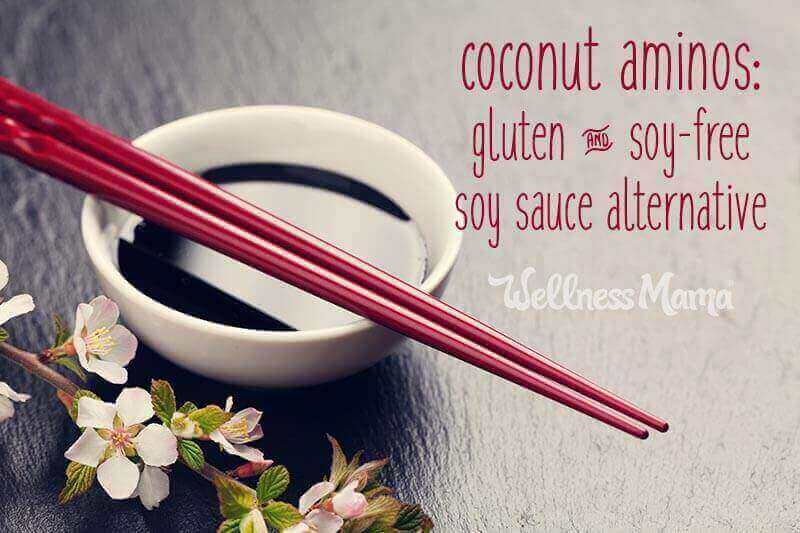
Health-conscious people often choose to eliminate soy from their diets. I love my stir frys and Asian-influenced dishes, so soy sauce is one staple I’d miss.
Thankfully, coconut aminos offers a tasty and even healthier alternative to soy sauce. If you’re already convinced, jump below to read about their benefits and how to use them in your family’s meals.
If not, read on!
Why Not Soy Sauce?
I’ve said before that if you’re going to consume soy you should choose fermented versions. Fermenting increases digestibility and has benefits that help negate some of soy’s harmful effects.
Since soy sauce comes from fermented bean paste, why am I still suggesting an alternative? Here are a few reasons:
It’s a common food allergen.
Many people react to soy whether it is fermented or not. Soy sauce often also contains wheat (gluten), another common allergen. (Coconut aminos is always gluten-free.)
It’s high in sodium.
We all know soy sauce is salty, but just a few teaspoons contain more than half of the daily recommended sodium intake for an entire day! You can purchase reduced sodium varieties, but coconut aminos (my recommended alternative) naturally contains 75% less salt than soy sauce.
It’s often a source of MSG.
Manufacturers commonly add coloring and chemical additives like MSG to enhance flavor or control saltiness. Consuming MSG can lead to migraine headaches, brain cell death, and impaired brain development in young children (source).
Commercial soy sauce usually isn’t made like traditional recipes.
Traditional soy sauce ferments naturally for a long period of time and is served raw to preserve the beneficial enzymes. Most commercial producers use a much faster high-tech process called “rapid hydrolysis” that changes naturally occurring glutamates into “an unnatural form of glutamic acid that closely resembles MSG” (source). Certain quality brands stick to more traditional methods, so do your research.
Enough with the bad stuff … enter coconut aminos!
The Many Benefits of Coconut Aminos
Ten years ago coconut products weren’t on most people’s radar, but today the market abounds with alternatives boasting the health benefits of coconuts.
Coconut aminos looks just like soy sauce and has a very similar flavor, though some describe it as more complex and having a more rounded flavor profile than soy sauce. It is made from the sap of the coconut tree, mixed with salt and aged to create a flavorful brew.
Coconut sap, the key ingredient in coconut aminos, offers many health benefits.
Low GI Scale
Although naturally sweet, coconut sap (and coconut aminos) rings in at a low 35 on the GI scale, so it won’t spike your blood sugar. This article discusses how low-GI foods reduce insulin issues and improve the “overall blood glucose and lipid concentrations” in both non-diabetics and diabetics.
Protective Cancer-Fighting Effects
Not only does coconut sap support healthy insulin levels and glucose metabolism, studies show it can have a protective effect on the kidneys. It also contains inositol, a B vitamin complex component that research suggests could help ward off prostate cancer.
Nutrient-Rich and pH-Balanced
Coconut sap contains a wide variety of minerals, vitamins, and amino acids (more on that in a minute), including high levels of potassium, vitamin C, and B vitamins (source). Its neutral pH also helps balance the body and make it alkaline.
(Almost) Complete Amino Acid Profile
Twenty different amino acids make up the proteins in our body. They function as the building blocks of life and are necessary for muscle development and brain health.
Our body can create some of these amino acids on its own, but 9 essential amino acids have to come through diet. Growing babies and children need all of the essential aminos, but they also need arginine, cysteine and tyrosine. Those who aren’t able to properly synthesize certain amino acids well because of genetics or age usually also need what are called conditionally essential amino acids (source).
Coconut sap and aminos have all 9 essential amino acids and 5 out of 7 of the conditionally essential amino acids, as well as a few others to help our bodies out. The sap also contains the amino acid glutamine, which doesn’t turn into MSG since coconut aminos isn’t fermented with a bacteria or yeast.
And that’s not it for good news!
Sustainably Produced
Interestingly enough, coconut trees do not produce coconuts when tapped for sap, since the sap is collected from the coconut blossoms before they mature. As a result some controversy exists about the sustainability of tapping coconut trees.
The Food and Agriculture Organization (FAO) of the World Bank and the Davao Research Center affirm tapping coconut trees for sap as an age-old and highly sustainable practice. For more on this topic, see this helpful article over at The Healthy Home Economist.
Now that you know about coconut aminos, put them to use in your kitchen today!
Where to Get Coconut Aminos:
Our local stores don’t carry this versatile condiment yet, so I order at a discount with my membership to Thrive Market. You can grab a free bottle of their coconut aminos here.
How to Use Coconut Aminos
Use coconut aminos in any recipe that calls for soy sauce. Avoid heating coconut aminos, as heat destroys the (natural and good) glutamine content. When you’re cooking, simply add them at the end of the recipe if possible.
Here are some Wellness Mama recipe ideas to get you started!
Healthy Vegetable Fried “Rice”
Meatball Shish Kabobs
Beef and Broccoli Stir Fry
Sweet and Sour Chicken
Cashew Chicken Lettuce Wraps
Grilled Thai Shrimp
Healthy Mandarin Chicken
Have you tried coconut aminos? If not, do you think you will try it?
Continue Reading...Why Coconut Aminos Should Be in Your Kitchen (+ Ways to Use)
source https://wellnessmama.com/139649/coconut-aminos-uses/?utm_source=rss&utm_medium=rss&utm_campaign=coconut-aminos-uses
